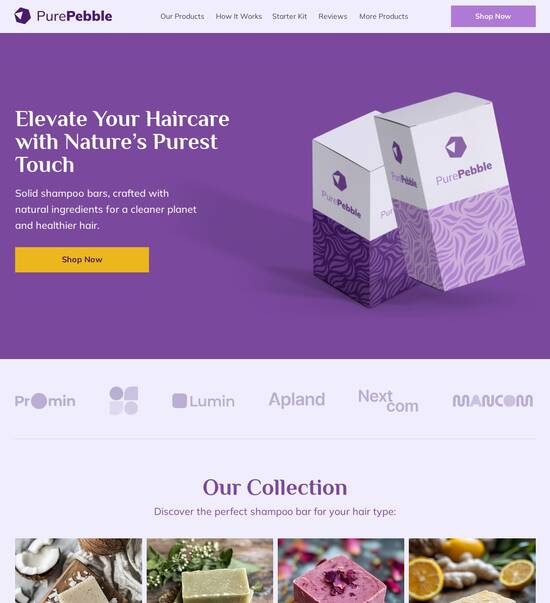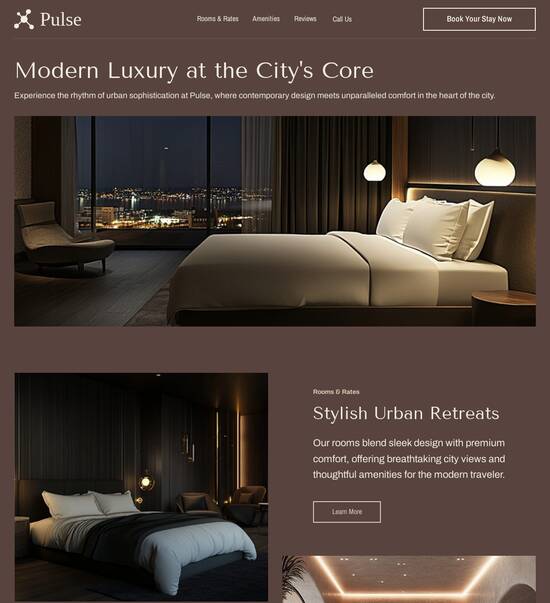
Next.js optimized reservation page template
Explore Similar TemplatesAbout template
Supercharge your reservation page with Next.js for outstanding performance! Learn more today.
Recommended templates

Easy to build without coding
With the intuitive drag-and-drop builder, anyone on your team can create high-converting pages without any knowledge of code or design. Make enhancements to your landing page with custom widgets using Javascript, HTML/CSS, or third-party scripts.

Multiple layouts for any industry and goal
Select from 500+ landing page layouts built to boost conversions across industry-specific scenarios. Customize them by adjusting fonts, adding images, and generating on-brand content with the AI assistant. Quickly scale with Instablocks® and Global Blocks that you can save, reuse, and update globally.

Loads fast and looks polished on any device
Every template is responsive, which means they present professionally on any device and load blazingly fast with our Thor Render Engine. You can also power them up with Google AMP technology to deliver an unparalleled mobile experience and drive higher conversions.

Robust analytics & experimentation
Get real-time updates and reporting across all your devices, showing the number of visitors, conversions, cost-per-visitor, and cost-per-lead. Launch AI-powered experiments, run A/B tests, and use heatmaps to analyze user behavior, then optimize your landing page to maximize conversions.







Easy to build without coding
With the intuitive drag-and-drop builder, anyone on your team can create high-converting pages without any knowledge of code or design. Make enhancements to your landing page with custom widgets using Javascript, HTML/CSS, or third-party scripts.
Multiple layouts for any industry and goal
Select from 500+ landing page layouts built to boost conversions across industry-specific scenarios. Customize them by adjusting fonts, adding images, and generating on-brand content with the AI assistant. Quickly scale with Instablocks® and Global Blocks that you can save, reuse, and update globally.
Loads fast and looks polished on any device
Every template is responsive, which means they present professionally on any device and load blazingly fast with our Thor Render Engine.
Robust analytics & experimentation
Get real-time updates and reporting across all your devices, showing the number of visitors, conversions, cost-per-visitor, and cost-per-lead. Launch AI-powered experiments, run A/B tests, and use heatmaps to analyze user behavior, then optimize your landing page to maximize conversions.
All the features you need to build lead-generating landing pages
Explore more featuresLearn how to build top-performing landing pages for any goal
FAQs
Leading the way in building high-performing landing pages





Maximize ROI with Instapage's landing page and CRO platform
In the competitive landscape of digital marketing, a high-performing landing page is vital. Instapage helps marketers across sectors like business services, financial services, and education to create impactful landing pages effortlessly. With its powerful features, users can drastically improve their conversion rates and overall ROI by leveraging ready-to-use templates and advanced optimization tools.
The Importance of a Landing Page
Having an efficient landing page is critical for successful online marketing campaigns. It acts as the first touchpoint for potential customers, influencing their purchasing decisions. For marketers in the USA, using platforms like Instapage enables quick deployment of high-converting pages to improve lead generation.
- First impressions matter: Capture user interest with fast-loading, visually appealing pages that reflect your brand.
- Targeted content: Tailor your messaging to the audience segment you are addressing, improving relevance and conversion rates.
- Analytics integration: Utilize built-in analytics to track performance, allowing for real-time optimization.
Step 1: Choose the Right Template
Start by selecting one of the 100+ high-converting templates available on Instapage. This step requires careful consideration to align the template with your campaign goals.
Step 2: Customize the Template
Once a template is selected, customize it to fit your brand's voice and style. Consider adding personalized features like dynamic text replacement and relevant lead gen elements to enhance user engagement.
- Brand alignment: Ensure all images, colors, and messaging resonate with your overall brand identity.
- User-centric design: Focus on a clear call to action (CTA) to guide users toward conversion.
- Mobile responsiveness: Optimize your design for mobile users, considering that a significant amount of traffic comes from mobile devices.
Step 3: Optimize for High Conversion Rates
After customizing your landing page, employ Instapage’s optimization features to ensure it is ready for launch. This may include A/B testing different headlines or CTA placements.
- Heatmap analysis: Utilize detailed heatmaps to assess where users are clicking and adjust your layout accordingly.
- A/B testing: Experiment with different versions of your page to see which performs best based on user behavior.
- Detailed analytics: Keep track of page performance metrics to facilitate ongoing improvements.
In summary, using Instapage streamlines the landing page creation process, thereby maximizing your campaign performance and ROI.
Ready to transform your marketing campaigns? Start using Instapage today to leverage its powerful tools for creating high-converting landing pages.
Next.js Optimized Reservation Page Template
Understanding the demand for modern reservation systems
The adoption of online reservation systems has escalated across various industries, including hospitality, restaurants, and healthcare. In a world where convenience is paramount, consumers prefer the ease of online booking to traditional methods. A study conducted by Statista indicated that more than 70% of consumers complete bookings online, a trend that's reshaping business models worldwide. This transition emphasizes the need for businesses to invest in robust reservation platforms.
The implications for businesses are significant. Those who fail to provide a seamless online booking experience may lose potential customers to competitors who prioritize user-friendly interfaces. Furthermore, an enhanced user experience can lead to higher reservation conversions, making a well-optimized reservation page not just a necessity, but a competitive edge.
Why choose Next.js for your reservation page?
Next.js stands out as a premier React framework, primarily due to its optimization for performance. Its capabilities for server-side rendering (SSR) and static site generation (SSG) make it a compelling choice for businesses looking to enhance their online presence. By pre-rendering pages, Next.js ensures fast load times and improved SEO performance that are vital in today’s digital landscape.
When compared to alternative frameworks like AngularJS and Nuxt, Next.js offers several advantages. Unlike AngularJS, which handles data binding and DOM manipulation differently, Next.js's simplicity in architecture allows developers to focus more on building engaging user interfaces rather than managing complex state. Moreover, incorporating Vue.js best practices in projects developed with Next.js can further enhance usability and maintainability.
Real-time page updates via SSR and SSG capabilities.
Easier integration with APIs and third-party services.
Active community and a wealth of plugins that simplify development.
Key features of an optimized reservation page template
Creating an engaging reservation page template is more than just a functional layout; it requires memorable features that engage users. Customizable booking forms play a critical role in this aspect. Using HTML5 allows developers to design forms that not only collect data efficiently but also enhance interactivity for the user. Moreover, utilizing Tailwind CSS can introduce interactive elements—such as live date pickers—into forms, thus providing a seamless user experience.
Responsive design is another critical aspect. With a growing number of users accessing services via mobile devices, employing mobile-first design principles ensures your reservation page is accessible to everyone. Tailwind CSS can help achieve this with its utility-first approach, allowing developers to implement adaptive interfaces while adhering to best practices in CSS.
Dynamic booking forms with user-friendly interfaces.
Mobile-first design ensuring accessibility on all devices.
Effective user authentication processes for secure reservations.
Frameworks and technologies behind the template
Understanding the technologies that power a reservation page template is crucial for effective development. Next.js features an organized pages and components architecture that allows for easy scaling. Developers can utilize distinct data fetching methods, such as getStaticProps for static generation or getServerSideProps for server-side rendering, to request data efficiently and deliver it to users rapidly.
HTML5 acts as a backbone for interactive elements in the reservation system, enhancing user input and engagement. Coupled with the flexibility of Tailwind CSS, developers can create visually appealing designs that can be easily customized based on specific business branding needs. Lastly, integration with APIs and databases facilitates seamless data handling, making the reservation process robust and reliable.
Developing the reservation page template: A step-by-step approach
To kick off the project, developers should initialize a new Next.js project using npm or yarn. The basic command is simple: 'npx create-next-app'. Once set up, it's essential to configure Tailwind CSS within the Next.js environment, which can be done by installing Tailwind and setting up your Tailwind configuration file appropriately.
Building the template structure requires careful organization of files and folders. This ensures optimal performance and easy maintainability. A foundational layout can be achieved through HTML5 templates, which serve as a base for dynamic components. By creating reusable React components for the booking forms and calendar widgets, developers can improve efficiency and streamlined updates across the application.
Initialize Next.js project.
Install and configure Tailwind CSS.
Organize file structure for scalability.
Performance optimization strategies
Performance is key in a successful user experience. To optimize load times, practices like image optimization and code splitting can make a substantial difference. Next.js allows for automatic code splitting, meaning users only load the scripts necessary for the page they are accessing, improving both speed and responsiveness.
Pre-rendering and caching strategies also play a vital role in optimizing performance. For example, caching data loaded from external APIs can alleviate server load and reduce the time it takes to retrieve information. Utilizing Tailwind CSS also helps minimize the overall CSS footprint, further enhancing loading speed without sacrificing design quality.
Enhancing user experience and accessibility
User experience (UX) design principles are particularly significant when developing reservation pages. A well-structured UX ensures that users can easily navigate through the booking process without facing obstacles. Incorporating real-time feedback mechanisms such as loading indicators and error messages can significantly enhance user interaction, keeping users informed throughout their reservation journey.
Accessibility is equally important, and compliance with ARIA standards in your Next.js components ensures that all users, including those with disabilities, can use the reservation system effectively. By taking the necessary steps to implement these standards, developers can provide a more inclusive environment and improve overall satisfaction rates.
Integration with backend services and APIs
Integrating with backend services forms the backbone of a functional reservation system. RESTful APIs or GraphQL can effectively manage reservation data and facilitate real-time updates. When planning integration, developers should prioritize secure methods for payment handling and user confirmation processes to maintain trust.
For example, utilizing databases like MongoDB or Firebase can streamline the storage of booking information, allowing for efficient data retrieval and seamless user interface interactions. This ensures that the reservation system remains responsive and can handle multiple requests simultaneously.
Testing and deployment of your reservation page
A crucial part of the development process is ensuring the quality of the reservation system. Utilizing testing frameworks like Jest for unit tests and Cypress for end-to-end tests can help identify bugs and ensure the application performs as expected. Writing comprehensive tests allows developers to catch issues early in the development process, improving reliability.
Once testing is complete, deploying the Next.js application on platforms like Vercel or Netlify is the next step. These platforms offer seamless integrations with version control tools, making it easy to push updates. After deployment, it’s essential to monitor system performance regularly, addressing any issues before they escalate and disrupt the user experience.
Examples of successful Next.js reservation implementations
Examining successful implementations of Next.js reservation systems can illuminate effective strategies and foster inspiration. Various businesses have adopted this framework to streamline their booking processes and enhance performance metrics. For instance, a case study of a popular restaurant's online reservation platform revealed a 40% increase in successful bookings post-implementation of a Next.js optimized template.
Similarly, a healthcare clinic optimized its appointment scheduling page using Next.js. The results showed significant improvements in load times and user satisfaction scores, highlighting how the right tools can transform reservation experiences. These examples showcase the potential of incorporating Next.js into your development strategy for tangible benefits.
Future-proofing your reservation page template
The digital landscape is always evolving, making it essential for businesses to stay ahead of the curve. Regular updates to your reservation page template based on emerging tech trends will prevent stagnation and ensure relevance. This could involve exploring the integration of machine learning for personalized booking recommendations or utilizing AI to streamline customer interactions.
Additionally, planning for scalability is vital. As businesses grow, their systems should accommodate increased traffic and functionality. By anticipating future demands and incorporating flexible architectures within your Next.js project, businesses can maintain impressive performance as they expand.
Conclusion: The road ahead for reservation systems
Next.js provides a powerful framework for developing optimized reservation systems that cater to current user preferences. By prioritizing features that enhance user experience, performance, and accessibility, businesses can not only meet but exceed customer expectations. The flexibility and scalability of Next.js ensure that developers have the tools necessary to innovate and create engaging online booking processes.
Embracing Next.js as part of your development strategy will position businesses advantageously in a competitive market. As technology evolves, continuing to explore the opportunities that this framework provides will enable remarkable transformations in reservation systems.
Ready to skyrocket conversions?
Supercharge your ad campaigns with high-performing landing pages
Get started














